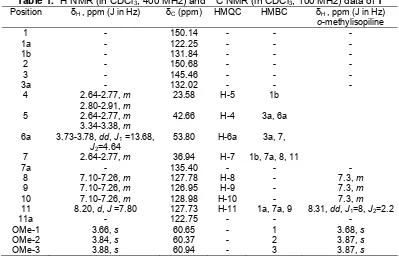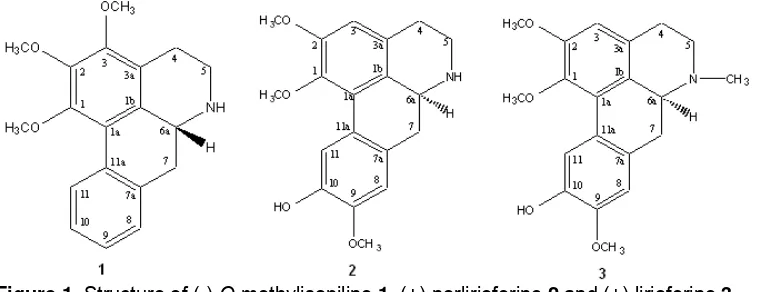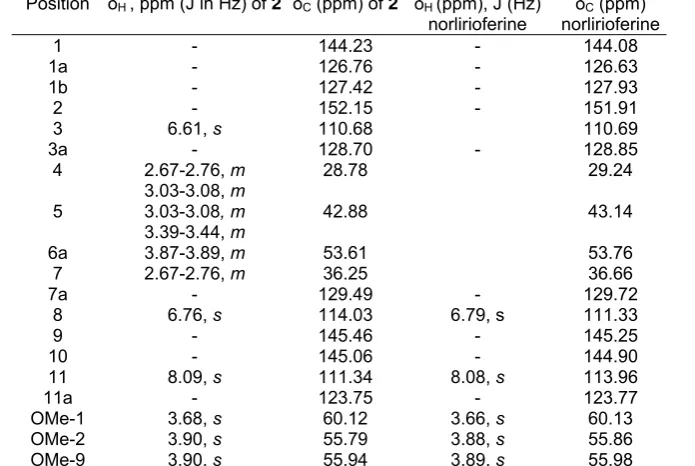Nurdin Saidi et al.
* Corresponding author. Tel/Fax : +62-651-7555264 Email address : noersaidi@yahoo.com
APHORPINE ALKALOIDS FROM BARK OF
Cryptocarya ferrea
Nurdin Saidi1.*, A. Hamid A. Hadi2, Khalijah Awang2, and Mat Ropi Mukhtar2 1
Department of Chemistry, Faculty of Mathematics and Natural Sciences, Syiah Kuala University, Banda Aceh, 23111
2
Department of Chemistry, Faculty of Science, University of Malaya K. Lumpur
Received July 27, 2009; Accepted October 20, 2009
ABSTRACT
Isolation, identification and characterization of the compounds isolated from the bark of Cryptocarya ferrea yielded three known aphorpine alkaloids. They are (-)-O-methylisopiline 1, (+)-norlirioferine 2 and (+)-lirioferine 3. Structural elucidation was established through several spectroscopic methods, such as 1D-NMR (1H, 13C, DEPT, NOE), 2D-NMR (COSY, NOESY, HMQC, HMBC), UV, IR, and MS and comparison with the published data.
Keywords: Cryptocarya ferrea; (-)-o-methylisopiline, (+)-norlirioferine, (+)-lirioferine
INTRODUCTION
Plants of the Lauraceae family are known to contain a variety of alkaloids and other chemical constituents, some of which are reported to have interesting pharmacological properties. Amongst Lauraceae family, C. ferrea is the species that has never been studied for its alkaloid constituents. However, other species of Cryptocarya have been previously reported. Using combination of reverse-phase liquid chromatography using ion-pair solvent system techniques, (+)-(1R, 1aR)-1a-hydroxymagnocurarine, oblongine, methyloblongine and xanthoplanine were isolated from Cryptocarya konishii [1]. Two alkaloids, (±)-romneine, a benzylisoquinoline, and cryprochine, a proaphorpine, were isolated from the leaves and bark of
C. Chinesis [2]. The Investigation and isolation of the leaves of C. chinensis yielded ten alkaloids, (-)-isocaryachine-N-oxide, Isoboldine-β-N-oxide, 1-hydroxycryprochine, (+)-isocaryachine, (+)-caryachine, caryachine, isocaryachine, isoboldine, (-)-munitagenine and bisnorargemonine [3].
Fifteen alkaloids were isolated from leaves, bark and root of C. longifolia, reticuline, N-methylcoclaurine, coclaurine, longifolidine, norisocorydine, laurotetanine,
N-methyllaurotetanine, isoboldine, laurolistine, norargemonine, bisnorargemonine, scoulerine, longifolonine, cryptoleurospermine, and thalifoline [4]. Alkaloid reticuline was isolated from dried bark of C.
foveolata [5]. From phytochemical investigation on the bark of C. amygdalina were isolated two olifinic acids, cryptocaryic acid and amygdalinic acid and two alkaloids, orientaline and laudanidine [6].
EXPERIMENTAL SECTION
Material
The industrial and analytical reagent grade solvent was used for extraction and column chromatography. Silica gel 60 and G-60 (70-230 mesh) ASTM (Merck 774) were used for Column Chromatography. Aluminium and glass supported silica gel 60 F254 were used for Thin Layer Chromatography and preparative TLC, respectively. The silica and plates were activated at 100 °C in the oven before used.
Bark of C. ferrea were collected at Tekai, Jerantut, Pahang, Malaysia. The plant materials were collected and identified by the phytochemical team, Chemistry Department, Faculty of Science, University of Malaya. The specimens were deposited at the Chemistry Herbarium, Faculty of Science, University of Malaya.
Instruments
Nurdin Saidi et al. Procedure
Extraction
Extraction of the bark (2.3 kg) was carried out by maceration overnight. The milled dried sample was defatted with 15 L of n-hexane. The n-hexane extract was then dried on the rotary evaporator. The plants material was dried and moistened with 10% NH3 and left overnight. They were then successively re-extracted with 25 L of dichloromethane and 10 L of methanol and then check with a Mayer’s reagent test after each extraction to make sure the extraction was completed.
Dichloromethane extract were concentrated under reduced pressure to a volume of about 500 mL and tested for alkaloids content using TLC and spraying with Dragendorff’s reagent. The dichloromethane extract were extracted with a solution of 5% hydrochloric acid (10 L) until Mayer’s test negative. The combined extract were then basified with 10% ammonia solution to about pH 11 and then re-extracted with dichloromethane. The crude of alkaloids fraction were dried with sodium sulphate anhydrous (500 g) and evaporated under reduced pressure.
Isolation
Crude of alkaloids (8 g) were isolated using Column Chromatography with silica gel 60 as stationary phase. The solvent system used for chromatography was dichloromethane with increasing portion of methanol (gradient elution system). The ratio of the solvent
between CH2Cl2 and CH3OH were (100:0; 99:1; 98:2; 96:4; 93:7; 90:10; 85:15; 80:10 and 50:50). Fractions were collected every 100 mL and each fraction was tested with aluminium TLC plate for their alkaloids. The alkaloid spots were first detected by UV light (254 and 366 nm) and confirmed by spraying with Dragendorff’s reagent. Fraction having spots with the same Rf values and stains were combined and treated as a group. The combined groups were isolated again with CC or preparative TLC to purify the alkaloids.
RESULT AND DISCUSSION
(-)-O-methylisopiline 1
Alkaloid (-)-o-methylisopiline 1, with [α]D 25
-27° (c = 0.015, MeOH) was obtained as a brownish amorphous solid. The UV spectrum exhibited maxima at 283 and 302 nm suggesting that compound is a noraporphine. The IR spectrum showed the presence of an NH group at 3424 cm-1.
The EI mass spectrum revealed a molecular ion peak at m/z 311 which corresponded to a molecular formula of C19H21NO3. The presence of the fragmentation at m/z 282 [M-29]+ indicated that alkaloid was an N-unsubstituted (NH) aphorphine [7]. Other significant peaks were also observed at m/z 310 (base peak), indicated the loss of H+, which was a characteristic of aporphine.
Nurdin Saidi et al.
Figure 1. Structure of (-)-O-methylisopiline 1, (+)-norlirioferine 2 and (+)-lirioferine 3
The 1H NMR spectrum showed the signals of three aromatic methoxyl groups at δ 3.66, δ 3.84 and δ 3.88, attached to C-1, C-2 and C-3, respectively. A downfield chemical shift was observed at δ 8.20 as a doublet (J = 7.80 Hz) and it is a typical of the hydrogen bonded H-11. Three aromatic protons were observed at δ 7.20-7.26 as a multiplet attached to C-8 and C-9, and C-10, respectively. The aliphatic protons gave a multiplet peaks between δ 2.64-3.78 ppm. The 13C NMR spectrum gave a total of 19 carbon atoms. The DEPT spectrum revealed three methoxyls, three methylenes, five methines and eight quaternary carbon signals. The assignments of 13C NMR is summarized in Table 1.
The HMBC experiment showed correlation of H-7 to C-1b, C-7a, C-8 and C-11. In addition, the signal of H-11 was correlated to C-1a, C-7a and C-9. While, proton OMe-1, OMe-2 and OMe-3 showed the long range correlations to the signal at C-1, C-2 and C-3, respectively.
Finally, assignment of all proton and carbon signals from DEPT, HMQC, COSY, HMBC and was identified by direct comparison with an authentic literature data [7-8] the alkaloid 1 was named o-methylisopiline.
(+)-Norlirioferine 2
(+)-Norlirioferine 2, with [α]D25 +45O (c = 0.02, MeOH) was isolated as a brownish amorphous solid. The UV spectrum indicated that the absorption at 314 nm is a typical of 1, 2, 9 and 10 tetrasubstituted aporphine [10]. These absorption peaks were due to the degree of resonance in the biphenyl system. The IR spectrum revealed absorptions at 3386 and 3317 cm-1 indicated the presence of hydroxyl and NH groups in the molecule.
The ESI+ mass spectrum showed [M+H]+ peak at m/z 328.2. The EI mass spectrum showed a molecular ion peak at m/z 327 corresponding to a molecular formula of C19H21NO4. The peak at m/z 298 [M-29]+ was due to the loss of methylene imine. The presence of
fragmentation at m/z 296 [M-31]+ suggested the C-1 was substituted by a methoxyl group. Moreover, the presence of fragmentation at m/z 298 [M-29]+ due to retro Diels-Alder mechanism, indicated that alkaloid was an N-unsubstituted (NH) aporphine [7].
The 1H NMR spectrum showed three aromatic proton signals appeared as singlet at δ 7.79 (s, H-11), 6.67 (s, H-8), and 6.52 (s, H-3). Three distinct methoxyl peaks at δ 3.58, 3.80 and 3.80 were assignable to attach to C-9, C-1 and C-2 respectively. The aliphatic protons appeared as multiplets at the region of
δ 2.57-3.79.
The 13C NMR spectrum showed the presence of 19 carbons and DEPT experiment showed that there are three methyls, three methylenes, four methines and nine quaternary carbons present in the molecule. The 1
H NMR and 13C NMR data are shown in Table 2. Finally, comparison with the published data [11], confirmed that alkaloid is (+)-norlirioferine 2.
(+)-Lirioferine 3
(+)-Lirioferine 3 was isolated as a pale brownish amorphous solid and [α]D25 +360 (c = 0.098, MeOH). The UV spectrum showed absorption maxima at 313 (sh) and 245 nm suggesting that 3 was a noraporphine type of alkaloid. The IR spectrum showed absorption peak at 3376 cm-1 indicated the presence of hydroxyl group in the structure.
Table 2.1H NMR (in CDCl3, 400 MHz) and
δ 7.98 assignable to H-3, H-8 and H-11, respectively. Three methoxyl groups which appeared as a singlet at
δ 3.57, δ 3.80 and δ 3.82 were attached to C-1, C-2 and C-9, respectively. One N-methyl singlet was observed at
δ 2.48 and the aliphatic protons appeared as a multiplet in the region between δ 2.54 to 3.06.
The 13C NMR spectrum established the presence of 20 carbons. The DEPT experiment showed four methyls, three methylenes, four methines and nine quaternary carbon signals in the molecule. The structural elucidation was completed by the help of the 2D experiments (COSY, HMQC and HMBC). Comparison with the authentic sample and its data from literature values [10,12-14], thus structure of 3
Nurdin Saidi et al.
was determined as illustrated and named (+)-Lirioferine.
CONCLUSION
Isolation, identification and characterization of the compounds isolated fromthe bark of Cryptocarya ferrea
yielded three known aphorpine alkaloids. They are (-)-O -methylisopiline 1, (+)-norlirioferine 2 and (+)-lirioferine 3.
ACKNOWLEDGEMENT
This work was supported by Technological and Professional Skill Development Sector Project, TPSDP, No. 465/J11/SPMU-TPSDP/2000 (Indonesian Government) and Vot F, No. F0142/2003B, PPF/FP092/2005C (Malaysian Government)
REFERENCES
1. Lee, S.S., Lin, Y.J., Chen, C.K., Liu, K.S., and Chen, C.H., 1993, J. Nat. Prod., 56, 11, 1971-1976.
2. Lee, S.S., Chen, C.H., and Liu, Y.C., 1993, J. Nat. Prod., 56, 2, 227-232.
3. Lin, F.W., Wu, P.L., and Wu, T.S., 2001, Chem. Pharm. Bull., 49, 10, 1292-1294.
4. Bick, I.R.C., Sevenet, T., Sinchai, W., Skelton, B.W., and White, A. H., 1981, Aust. J. Chem., 34, 195-200.
5. Lamberton, J.A. and Vashist, V.N., 1972, Aust. J. Chem., 25, 2737-2738.
6. Borthakur, N., Mahanta, P.K., and Rastogi, R.C., 1981, Phytochem., 20, 501-504.
7. Ohashi, M., Wilson, J.M., Budzikiewicz, H., Shamma, M., Slusarchyk, W.A., and Djerassi, C., 1963, Am. Chem. Soc., 85, 2807-2809.
8. Chen, C.L. and Chang, H., 1978, Phytochem., 17, 779-782.
9. Connolly, J.D., Haque, M.E., and Kadir, A.A., 1996,
Phytochem., 43, 1, 779-782.
10. Chen, C.H., Chang, H.M., Cowling, E.B., Hsu, C.Y.H., and Gates, R. P., 1976, Phytochem., 15, 1161-1167.
11. Castro, O.C., Lopes, J.L., and Vergera, A.G., 1985,
Phytochem., 24, 1, 203-204.
12. Marsaioli, A.J., Reis, F. de A.M., Magalhaes, A.F., and Ruveda, E.A., 1979, Phytochem., 18, 165-169. 13. Smolnycki, W.D., Maniot, J.L., Hindenlang, D.M.,
Miana, G.A., and Shamma, M., 1978, Tetrahedron Lett., 47, 4617-4620.


